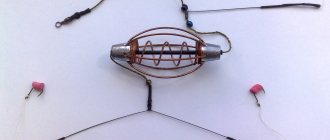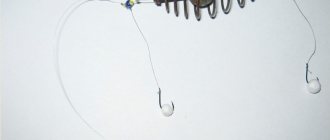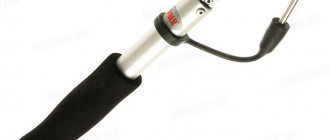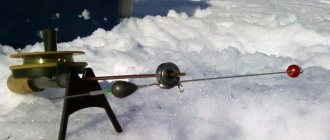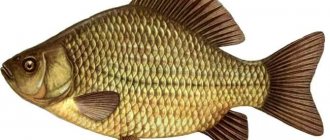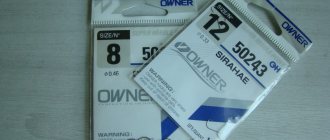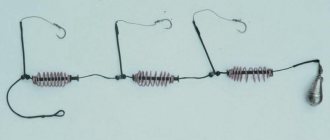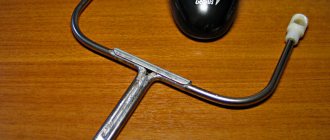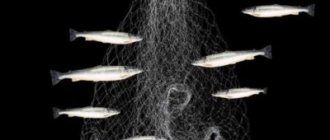When starting to fish, beginners learn a lot of new things and learn how to behave correctly on a pond, how to choose a place, bait and bait, as well as how to tie rigs correctly.
In order for the first impressions to be positive, and the craving for fishing to remain for many years, you need to learn how to make simple but catchy gear that is used on all types of reservoirs and for different fish.
First of all, this concerns bottom rigs, which are used to catch small fish such as crucian carp or perch, and large fish - carp, carp, catfish.
The purpose of this article is to help a beginner figure out how to make a donk and what you need to pay attention to in order to get a catchy tackle.
Are there any advantages to homemade donks?
As you know, a lot of bottom equipment has been invented and each of them helps to solve a specific problem and catch trophy fish in specific conditions. Donks are also sold in specialized fishing stores and the easiest way is to just buy them, especially since there is a large selection.
But not everyone has the necessary budget, and the main thing is that homemade gear often turns out to be more catchy than purchased gear, and this is proven by specific results.
In addition, it is much more pleasant to pull out pike perch or carp on a donk made with your own hands and modified for certain conditions.
No matter how strange it may sound, grandfather’s donks fish with ultra-modern gear, and the price of the materials necessary for their manufacture is extremely low.
Advantages of homemade donks:
- low cost of materials;
- design variability;
- compactness;
- quick preparation for use;
- the ability to use several homemade gear at the same time;
- use of all kinds of baits, lures and baits.
It is also important that a novice fisherman can try fishing with homemade donks and decide whether fishing will become a real hobby for him.
What does a simple donka consist of?
Already from the name it is clear that bottom tackle is used for catching fish that live in the lower layers of water. To immerse a leash with a hook, you need a sinker, and to fix the tackle on the shore of a reservoir, you need a stand or a slat.
In general, a regular donkey-trick consists of:
- reels or bobbins on which the main fishing line is wound;
- racks for fixing gear on the shore;
- mechanical alarm;
- main line;
- installation with a sinker.
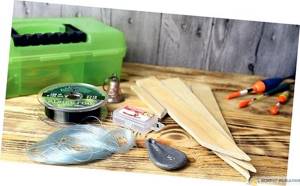
Of all the elements of equipment in the store, you will have to buy fishing line for the base and leashes, as well as hooks. For the base of the bait, you don’t need expensive fishing line, so buy a simple fishing line in a 100-meter reel with a diameter of 0-35-0.40 mm in the store.
One hundred meters will be enough because it is difficult, if not impossible, to throw a long distance with your hand. Usually this is 50–70 meters and there is still some reserve left for landing large fish.
Such a fish cannot be brought out “scrambly”, otherwise it will fall off the hook, so sometimes you have to release 5-10 meters of fishing line from the reel in order to tire the trophy and bring it to the shore. Line for leashes with a diameter of 0.18-0.22 can also be bought in the store, and there is a special leash line unrolled for 25–50 meters.
You will need 3–4 hooks, numbers 4–6 according to the European classification. The reel, sinker, stand and signaling device are made by hand, and their quality will be no worse than that of store-bought products.
Types of donks
The main principle of a big catch is the correct assembly of the equipment, the presence of an adequate sinker, timely complementary feeding and competent actions during the fishing process.
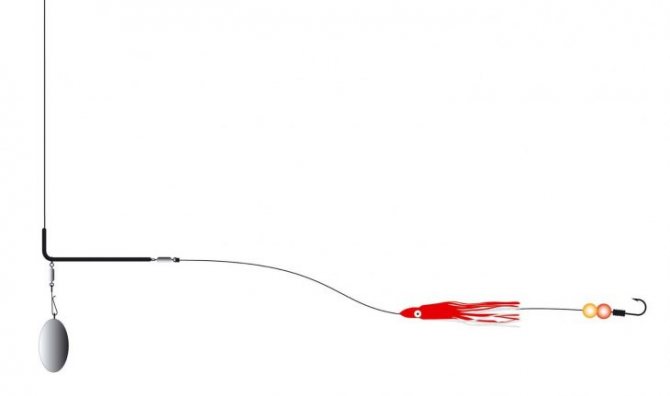
At the moment there is a large variation of donks:
- The classic version using a spring.
- Universal snacks.
- Installation with rubber band.
- Predator killers.
- Feeder type.
- Makushatniki.
- Onboard rigs using a ring.
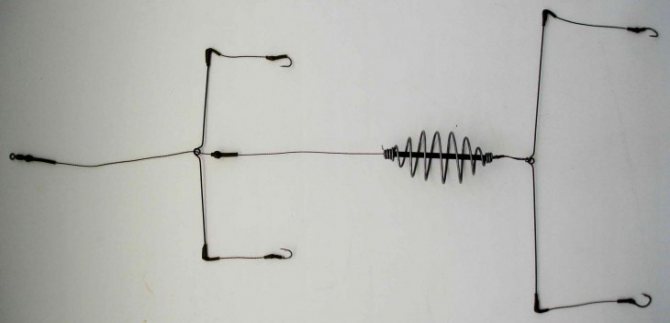
Read here How to tie a hook to a fishing line - advice from professionals and the best patterns for beginners (115 photos and videos)
«>
The types of bottom gear vary depending on the type and depth of the reservoir. If fishing occurs in a fast current, then it is necessary to use heavy weights so that the current does not wash them away along with the hook.
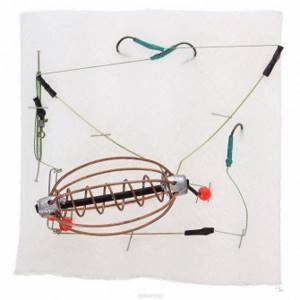
If the water in the river is predominantly of a stagnant type, then the weight and equipment should be chosen small; the tackle will respond better to the bite.
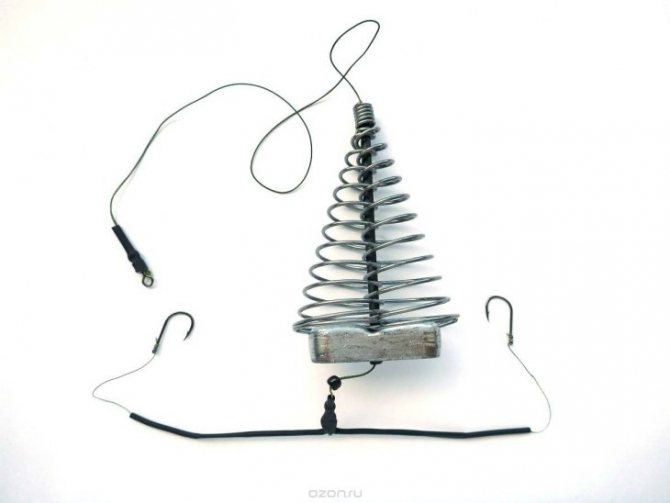
By variety, bottom gear is divided into types:
- The rubber band is used at shallow depths. The rigging of a donkey with an elastic band for standing water is 3-3.5 mm, for small currents - 4, and for rivers with strong currents 6 mm;
- Makushatnik - a cake is built into a lead plate, the ends of which are hidden in the crown;
- Nipple - make a feeder with a lid using lead with the addition of glass containers for prepared bait;
- Ring - made by hand from steel, shaped into a ring shape with a narrow base for fastening;
- Eggs - a thread of fishing line is threaded into the hole, and a fishing line is laid through the lead balls.
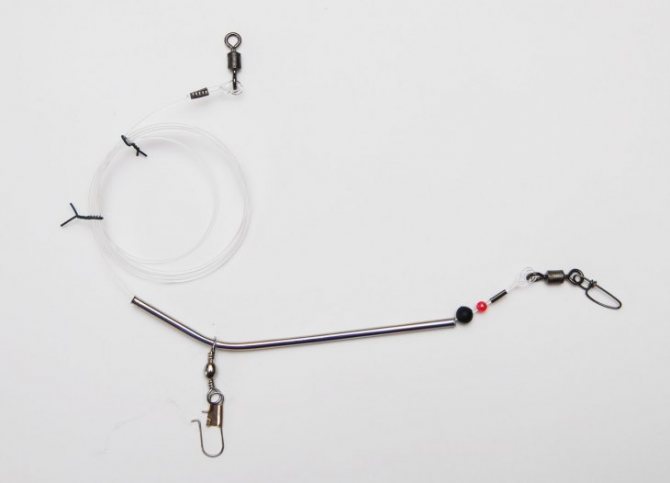
Rigging a donkey for fishing from the shore is done in 2 ways:
- With a fishing rod. Install stands and loosen the friction brake of the reel, prepare any object or device that will signal a bite;
- Without a rod. Fishermen mainly drive in strong branches for convenience.
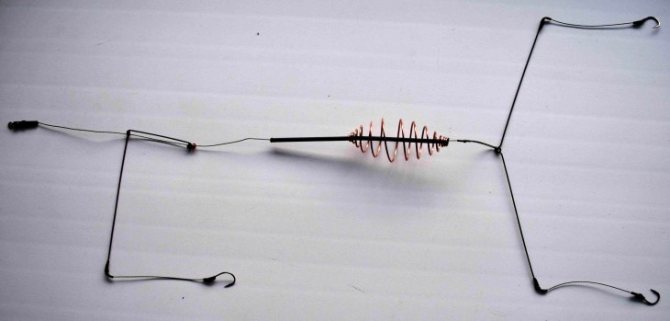
How to make a reel
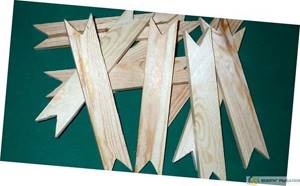
The reel is made of a board or piece of plastic 30 cm long and 6 cm wide. Its main feature is that V-shaped cuts are made on the end sides for easy winding of fishing line. It is not difficult to cut such cutouts with a jigsaw or on a machine, as well as to clean them with sandpaper.
On one side, one leg on the reel should be 8–10 cm longer than the other; it is inserted into the sand or soil when installing the bait before fishing. After the reel is completely processed, all the fishing line from a 100-meter reel is wound onto it.
How and from what to pour a sinker
Most sinkers used in industrial fishing are made of lead. It is the heaviest metal available, which is why it is used to make tool weights. It’s also not difficult to find a piece of lead for casting a load on a charger; in particular, it is found in old car batteries.
Lead melts at a temperature of 327º, so sinkers can be made using a homemade method at home. First you need to make a mold for casting. To do this, wet sand is poured into an empty tin can, in which a depression is made with your fingers in the shape of the future sinker.
In order for the sinker on the hook to “hold the bottom” well, it is made flat and oval in shape. That is, the depression in the sand is also made in the shape of an oval.
The sinker must have a hole for attaching to the fishing line, so on one side of the future sinker (at the top of the oval), a nail is inserted into the sand. After this, the pieces of lead are placed in another tin can and heated on a regular gas stove or over a fire.
After the lead has melted, it is poured into a sand mold and left until it cools completely. A nail is removed from the cooled sinker with pliers, and the surface is treated with a file or sandpaper.
Lead is a soft metal and lends itself well to processing, so making the load completely smooth is also not difficult. Typically, fishermen prepare a supply of lead weights so that if the gear breaks while fishing, they can quickly replace it and continue fishing.
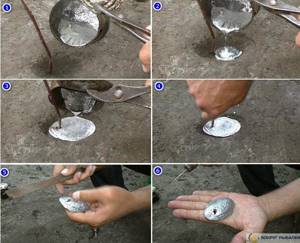
Stand and alarm
The casting stand is made of a metal rod 80-100 cm long. On one side of the rod, 20 cm of its length is bent in the shape of a V for ease of laying and tensioning the fishing line. It is advisable to treat the surface until it is smooth so as not to damage the fishing line when fishing.
The signaling device is made of a piece of rubber 3 cm long and 6 cm wide, in one end of which a slot is made to fix the fishing line, and on the other side (also in the slot) a small school bell is inserted. To prevent the bell from flying out of the elastic band after sharp jerks, the joint is glued.
Improving the Donkey Trick
To increase fishing efficiency and lure fish to baited hooks, fishermen use spring feeders into which tasty-smelling bait is filled.
Pacifier springs are also made by hand from copper wire wound on a solid base. Installing such a sliding spring between the sinker and the first leash will increase the attractiveness of the hook, and therefore its effectiveness.
By the way, the well-known crucian carp killer donk rig is an improved donk with 2–3 springs and 3–4 leashes on soft leash material. This means that if a fisherman knows how to make a classic hook, then it will be much easier for him to learn how to tie other bottom rigs.
Donka from a spinning rod
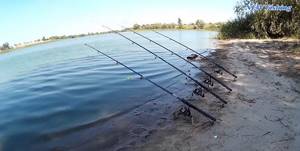
The next stage is making a donkey from a spinning rod, which will help you fish distant areas of the reservoir and increase the efficiency of fishing. When most experienced fishermen mention spinning, for some reason they immediately imagine an expensive spinning rod with a cast of 10–20 grams.
In fact, there are different types of spinning rods, and the well-known “crocodile” is, in fact, also a spinning rod, only rough but powerful. With such a spinning rod they throw far and do not experience any problems when landing large fish, because it is not afraid of the most serious loads.
Another type of spinning rods used as rods are inexpensive telescopic rods, easy to transport and reliable in operation. The length of such rods varies from 2.40 to 3.00 meters, so there is a choice and it depends on the conditions in which the bottom fishing will be carried out.
Powerful spinning rods are the best rods for amateur bottom fishing in terms of price-quality ratio.
Important! The taller the fisherman, the longer the spinning rod he needs to choose; it is more convenient to cast and easier to fish.
Coil
If, when fishing with a cast, the bottom tackle is cast by the fisherman “by hand,” then for casting from a spinning rod, a reel is needed. Without a reel, you simply won’t be able to cast the rig far, and landing fish will be difficult.
An inertial reel is not suitable for donkeying, so you need a spinning reel with a front or rear clutch. Such reels have a reliable mechanism, closed with a waterproof case, and with regular technical maintenance (lubrication, cleaning), they will last for more than one season.
To use a spinning rod, you don’t need an expensive spinning reel, and there are a lot of budget models and plenty to choose from.
The main characteristics of the inertia-free machine:
- spool size;
- number of bearings;
- clutch location;
- presence of a baitrunner;
- landing paw size;
- material;
- price.
In most spinning reels, the handle is moved to the right or left, so the angler chooses the option that is more convenient for him. The size of the spool determines the amount of fishing line that can be wound, as well as the convenience of casting, especially over long distances. The larger the spool, the more convenient it is to cast far, but making long, powerful casts requires skill and technique.
Beginning fishermen believe that the more bearings there are in a reel, the more reliable and convenient it is to use. This is not entirely true, since the material from which the bearings are made is also important and it is better if they are metal. Unscrupulous manufacturers hide the fact that instead of metal bearings, their products contain plastic bushings, and before purchasing, you need to make sure of the quality of the product.
Almost all modern spinning reels are equipped with a front or rear drag. Some products have both front and rear clutches, with the help of which the beyrunner system is adjusted. But for a budget donkey from a spinning rod, a reel with a front drag without a baitrunner is suitable; it will cost less, but will cope with the assigned functions.
Donka protozoa (classical)
Fishing / Fishing gear / Protozoan donka (classic)
If you double the length of the fishing line on a float rod, move the float to the very tip of the rod and make the load heavier, this tackle will become the prototype of the simplest donkey. This, by the way, is what many floaters do when, after a flood or rain, they have to fish in cloudy water or in a very strong current. However, the simplest donka does not require such a long rod: it is not involved in casting, hooking, or fishing for prey. All these operations are performed exclusively by the hands of the fisherman. And a float hanging above the water is not the best “watchman” for bites.
The simplest fishing rod consists of a short (up to 1 m) fishing rod equipped with a reel or reel, a supply of fishing line of 35-50 m, a sinker and leashes with hooks.
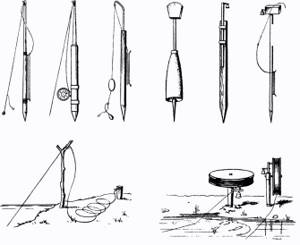
Rice. 45. General view of the simplest donok. The fishing rod is usually made from thin wood (usually juniper) whip. The butt end is sharpened to make it easier to stick into the ground, and at the tip there is a loop for attaching the fishing line in working condition. This loop is made exactly the same way as on a float fishing rod: a piece of fishing line with a diameter of 0.35-0.5 mm bent in half is wound with threads to the fishing rod 1.5-2 cm below the cut of the tip and the winding is impregnated with waterproof glue. If the fishing rod is equipped with a reel, then it is more advisable to install a tulip ring on its tip. Many lovers of unpretentious gear store the fishing line on a reel made of plywood or foam plastic (they go fishing “light”, with a briefcase), and make a fishing rod on the shore from a branch of a willow bush that grows locally. To secure the fishing line in working condition, it is inserted into a small slot; made with a knife in the top of the rod. It is hardly worth encouraging such amateur activity: after all, the bush will be damaged in vain - after fishing, the cut twig, as a rule, turns out to be thrown away as unnecessary. Those who act more decently are those who make fishing rods for donks from various auxiliary materials - from metal tubes, steel rods and plates, from vinyl plastic, etc. Equipped with various signaling devices, they reliably perform their service. Many fishermen are increasingly using short (up to 2 m) factory-made rods made of bamboo, fiberglass and carbon fiber, equipped with reels and guide rings for bottom hunting. But if fishing rods amaze the imagination with their diversity, the same cannot be said about fishing lines. Since you have to hunt with a bottom fishing rod in a variety of conditions, the main requirement for a fishing line is its versatility. Firstly, so that it could withstand the fight against large prey, and, secondly, it would not greatly coarse the tackle. Silone fishing lines with a diameter of 0.35-0.50 mm are considered the most suitable for donks. The next most important part of the donkey is the sinker. There are also more than enough fantasies here. But when choosing the shape, weight of the load and the method of attaching it to the scaffolding, one must be guided by considerations of expediency. For example, if the coastal section of the bottom is flat, then it is unlikely that it will be convenient to use a light load here: you cannot cast it far, and there are no fish close. On the contrary, on a lake, pond or river with a weak current, a very heavy load is not needed. If the bottom of the reservoir is muddy or rocky, a “pellet” is more practical - a round-shaped weight. In a strong current with a sandy bottom, it will be better to “lie” a flat load. The main material for the manufacture of bottom sinkers is lead or its compounds. The main one, but not the only one. Some craftsmen manage to use clay, cake, steel spiral springs and even cans as sinkers. Moreover, they use it with great success. We will dwell on the search for innovators a little later, but for now we will answer the question: how are donk sinkers attached to the fishing line? Three methods of fastening are widely used. The first and most practical is when the sinker is tied to the end of the working part of the fishing line, and 1-2 leashes 15-25 cm long are placed above it. The second is when the load has a longitudinal through hole and slides above the leads along a fishing line passed through this hole. The carbine with which the leashes are connected to the main fishing line also serves as a limiter for the downward movement of the sliding sinker. This method of fastening also has many adherents. There is an opinion that in this case the fish that grabs the bait does not have to overcome the resistance of the sinker, and the bite is immediately transferred to the fishing line. However, practice shows that this is not always the case. For example, during the current, the line makes an arc and almost completely dampens the jerks of the fish that grabs the nozzle. Finally, the third method is when the load on a separate undergrowth 40-50 cm long is placed between leashes tied to the main fishing line both above and below the place where the load is attached. The leashes are located at such a distance from each other to prevent hooks from catching.
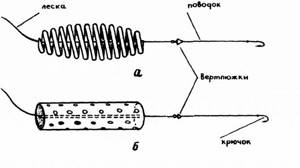
Rice. 46. Lure weights: a - made of a steel twisted spring, b - made of tin The question of which of the three listed methods of attaching sinkers is more “catchable” does not have a clear answer. Apparently, the best method is the one the fisherman is used to. But sinkers made in an “unconventional way” have a really significant impact on catchability. What kind of sinker is this?
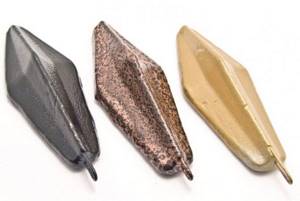
Groundbait is known to significantly increase the chances of success. This is what the innovators took into account. There are several designs of bait sinkers (see Fig. 46). For example, a double-cone steel spring (the diameter of its widest middle ring is no more than 3 cm) is put on a thin metal tube (like the refill of a ballpoint pen) 5-7 cm long and soldered to the ends of the tube with its small end rings. The fishing line is passed through a tube. A leash with a hook is tied to the end of the fishing line on a swivel. The swivel (carabiner) limits the sliding of the bait to the hook. Before fishing begins, a thick mass of food (porridge) is rubbed inside the spring, which, by the way, stays there for quite a long time. From such a sinker thrown into the water, the current washes away crumbs that form a “path” and attract fish. A cylindrical bait box of the same principle is made from tin, or, more simply, from suitable tin cans. It consists of two halves that fit tightly into each other. There are holes drilled in them through which food enters the water. When adding food, the halves are separated (like a student's pencil case). Even more original are bait sinkers made from “non-traditional” materials. This is how Kolomna fishermen make the so-called “bomboshka”. Two identical leashes 40-50 cm long are tied to the main line of the bottom fishing rod on one carbine. On the shore, a ball the size of a tennis ball is sculpted from viscous clay. “Hercules” is scattered on plastic film and the ball is rolled over it until it is completely covered with these flakes. Then two shallow cuts are made on the sides of the ball and a leash is stuck in them. Moreover, they are sealed so that only very short pieces of leashes with hooks stick out from the ball (see Fig. 47). The sinker is ready! Now, like an ordinary stone, it is thrown into the right place. Attracted by the food, the fish approaches the tackle, plucks the petals of the “Hercules”, and along with them grabs the bait.
Rice. 47. “Bomboshka” Tambov fishermen, when fishing for carp and carp in ponds, use sunflower cake to make feeder sinkers. 2-3 hooks are inserted into a piece of non-rigid cake measuring 4x4x2 cm and the piece is thrown into the water. Soaking cake attracts fish. She comes up and begins to suck on the soggy surface of the piece. This is where the hook drops into her mouth along with the food. Now - about leashes and hooks. On bottom fishing rods, as a rule, leashes are placed one and a half to two times thinner than the main fishing line. Their length ranges from 10 to 50 cm. The trend is this: the shorter the leash, the better, it gets less tangled. The debate is only about the number of leashes on one fishing rod. Some believe: more leashes mean more chances for fish to meet the bait. Others reasonably note that fish are more likely to encounter bait that lies in the water rather than on the shore. And with many leashes, the tackle is more likely to be on the shore: you thread one hook - the rest wait their turn. In addition, the Recreational Fishing Rules prohibit one angler from having more than 10 hooks. Practice has shown: the fewer hooks, the more active the donk. Therefore, it is better to have two donks with two or three hooks than one with 7-10 hooks. In addition, “shaggy” tackle means inevitable snags on the grass on the shore, “beards” from leashes when casting, and a danger of injury when landing fish. The conclusion suggests itself - we must strive to make the tackle more sporty. Among the primary concerns of the milker is tying the leashes to the main fishing line. This operation is carried out in several ways. Some fishermen, especially beginners, without further ado, make a knot on the fishing line, and before tightening it, insert the upper tip of the leash with a hook into it, in turn make a knot on the inserted tip of the leash, and then tighten both knots. Simple, fast, but, firstly, unreliable: knots are the enemies of strength, and a small knot on a leash may not hold a large fish, it will slip out, and, secondly, if the leash breaks, you need to tie a new knot on the fishing line (the old can’t be unraveled anymore), but this is not so easy on an outstretched tackle. It’s easy, you’ll have to at least partially reel it in. Less hassle with “sliding” leashes. On the main line, several double (according to the expected number of leashes) or even triple large knots are made. Above each of them, a leash is attached with a self-tightening loop or a simple knot and moved down to the fishing line knot. With this option, it is easy to make up for the loss of a leash by tying a new one in its place. But the angler will not have the opportunity to resist the forward throw of a pecked fish: dragging along the leash sliding up the line, it will not feel the proper resistance and will most likely spit out the bait. There will simply be nothing to hook the fish during this maneuver: the leash will go freely to the nearest upper node.
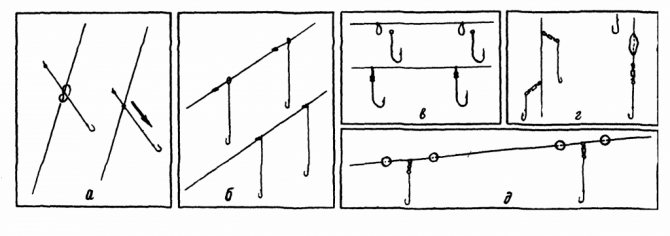
Rice. 48. Methods of attaching leashes to a bottom fishing rod: a - with two knots; b - sliding knot; c - slip loop; g - using a carabiner; d - using the “necklace” method. A more reliable method should be considered when not knots are made on the main line, but loops, and leashes are attached to them (loop to loop). This fastening allows you to quickly change any leash, depending on fishing conditions. But these loops make the tackle “shaggy” and more alarming to the fish.

True, this must be taken into account only insofar as. There is no gear that is completely invisible to fish. And low reliability is often more upsetting (especially when large prey is lost) than lack of bite. Therefore, when equipping the gear, you should adhere to the golden mean: make it as less noticeable as possible, but not at the expense of reliability. These requirements are sufficiently met by methods of attaching leashes using swivel carabiners. There are two of them. The first is when the carabiner is connected to the fishing line with a blind knot (it sticks out perpendicularly to the side of the fishing line), and a short leash is tied to its free ring with a cap loop. And the second - when small beads are placed on the main fishing line, and swivel carabiners are placed between them. It turns out to be a kind of “necklace”. This is how it is done. Take a small bead and slide it onto the fishing line to the place where the leash should be attached. Then the free end of the fishing line is passed through the bead two more times (to prevent it from crawling). After this procedure, a swivel is put on the fishing line (in one ring), followed by a second bead. The fishing line is also passed through it twice. The distance from one bead to another should not exceed 1 cm. In this space, the swivel with a leash tied to it will “run”. This type of fastening also has the advantage that the leash can move freely around the fishing line without twisting on it. There are no special requirements for donk hooks. Use the same ones as for a float fishing rod. Although their size should be somewhat larger. The most popular are hooks No. 6-8.5. It is desirable, of course, that they have a longer fore-end, especially if they are to be planted with dung or earthworms. But if they are not there, it doesn’t matter. But you need to be extremely careful about the condition of the sting. It is known that a long fishing line cannot make a good hook - it absorbs, and therefore a blunt hook will not dig into the fish’s mouth. Hence the conclusion - the hook tip must be extremely sharp. Experienced fishermen check the sharpness of the sting before each bait: when placed perpendicular to the nail of the thumb, it should not slip. Otherwise, it should be sharpened immediately. Good donk hooks are made in the village of Bezvodny, Kstovsky district. They are called “Bezvodninsky”. Serious troubles for the fisherman are caused by leashes with hooks (especially if there are a lot of them), when it is necessary to bring the tackle from a traveling state to a working one and vice versa: the hooks of the donkeys have the ability to catch on the fishing line or each other on the reel in such a way that it takes quite a lot of time (and on the shore it is “precious”) to their separation. And if the fishing rod is equipped with a reel and guide rings, then hooks are a total hassle. However, inquisitive people found a way out of the situation. A ring cut from nipple bicycle rubber is put on the main line next to each leash. A leash with a hook is pulled under this ring. Then the ring is moved to the desired place and the hook is hooked onto it. Now the donkey line is wound onto the reel or reel without interference and unwinds from them. The hooks are held even more securely in the “neutral” position when the locking rings are made of pieces of soft but dense rubber. Holes for passing fishing line and leashes are pierced with an awl. Such rings are dragged along the fishing line with some effort.
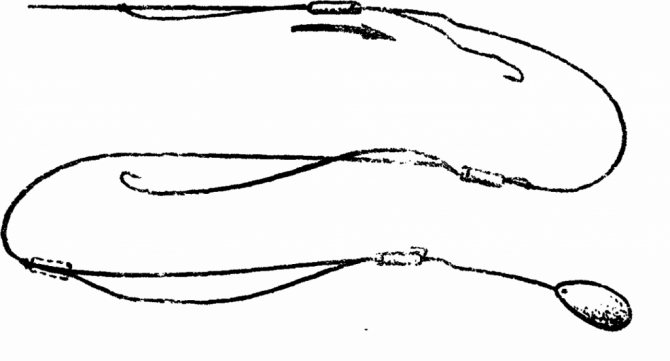
Rice. 49. “Neutralization of hooks using rubber rings” They are used to “neutralize” hooks and tubes made of vinyl chloride (pieces of wire insulation), but their “efficiency” is lower than rubber ones. The last (not least!) detail of the donkey is the guardhouse. It is he who notifies the angler that the fish is interested in the bait. The design variety of guardhouses is as great as that of fishing rods. Sometimes they are a direct continuation of each other (see Fig. 50).
Rice. 50. Convenient guard The tackle shown in this figure was invented by the Voronezh fisherman I. Sergeev. I’ll tell you more about it especially for those who cut fishing rods from the shoots of young trees growing on the shore. Don't do this! It is much more practical and without damage to nature to make a donka at home. You need to take a piece of thin board, cut a reel on the side, sharpen the lower end, and make a deep (5-7 cm) hole in the upper end with a thin drill or a hot nail - a nest for the guard. The guard itself is made of elastic steel wire (bicycle spokes). A bell is attached to its upper end. And in the middle there is a bend to clamp the fishing line. This tackle is light and convenient (can be carried in a briefcase!): the stand is securely held in the ground, and the bell is sensitive to the slightest touch of the fish to the nozzle.
Rice. Groundbait on sinkers It must be said that on bottoms the bell is used more often than other devices as a guard. This is understandable - double notification: visual and audio. It is especially necessary when fishing at night. And although craftsmen have invented many watchmen who give light signals in the dark, they cannot yet compete with the bell. On the bottom, the length of which does not need to be constantly changed during fishing, the bell is suspended in a “blind” manner: 20-30 cm from the tip of the fishing rod, a loop is made on the fishing line, threaded through the eye of the bell and tightened loosely (see Fig. 51). If the fishing rod is equipped with a reel and during fishing you have to frequently change the casting distance, a “blind” fastening of the guard is not suitable. So that the bell does not become an obstacle when winding the fishing line, it is tied not to it, but to a separate leash 40-50 cm long, as shown in Fig. 52. The second end of this leash is threaded into a hole made with an awl in one of the halves of a wooden clothespin and tied with a knot. The clothespin is attached to the tip of the fishing rod, and the bell on the leash is thrown over the working part of the main fishing line. This device allows you to drop the bell from the main line during hooking, and it can move freely through the guide ring. Noteworthy are the designs of donks in which the bell guard does not have direct contact with the main fishing line, which provides the angler with greater freedom of action. For example, on the “French” tackle (see Fig. 45 “g”) the bell hangs on a plate spring attached to the fishing rod leg. It is put into action as follows: when the fish pulls the fishing line, the reel on which it is wound begins to rotate, and a peg attached to the reel strikes a spring with a bell.
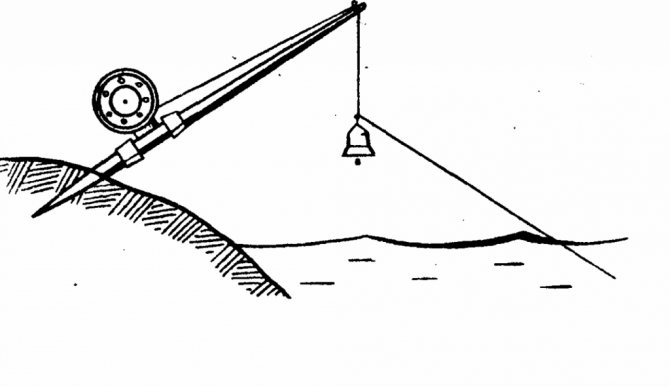
Rice. 51. Lodge of the simplest donkey Astrakhan amateurs fish from rocky shores with donkeys, the fishing rods for which are made of metal rods with a diameter of 4-6 mm. The lower end of such a fishing rod is pointed to make it easier to stick it between the stones, and the upper end is fitted with a piece of hard rubber measuring 7x3x2 cm. A piece of thin wire is inserted into the side of the rubber, to which a bell is attached. A slot is made in the top of the piece of rubber to pinch the fishing line (see Fig. 45 “e”). As soon as the fish pulls the line, the rubber begins to vibrate and activates the bell.
Rice. 52. A device for resetting a guard during cutting . Stearine candles, lead plates, picked up on the shore... pebbles are also used as “guards”. Stearin attracts attention because it is clearly visible in the twilight: the candle is usually tied to the main fishing line with a thread. A lead plate bent in half is hung on a fishing line 40-50 cm from the tip of the rod. With its weight, it makes a small angle on the fishing line and when it bites, it rises up or falls down. Such lead guards (they are called “plumb line”) are held in high esteem by those who fish on lakes in the floodplain of the Upper Volga. And pebbles... pebbles are used by those who go fishing lightly and do not carry rods with them. Having cast a bottom, such an angler places a boulder on the top of a fishing rod cut here and waits for it to fall, which means there has been a bite. It seems that there is not one iota of sportiness in such fishing. Of course, even the most perfect donkey cannot be called a highly active tackle. This is not a float rod, but more - not wire or fly fishing, with which the fisherman is in constant movement. Donka does not require such “nimbleness.” But if the angler knows the fishing technique well and the features of his tackle, he will certainly enjoy fishing with donka.
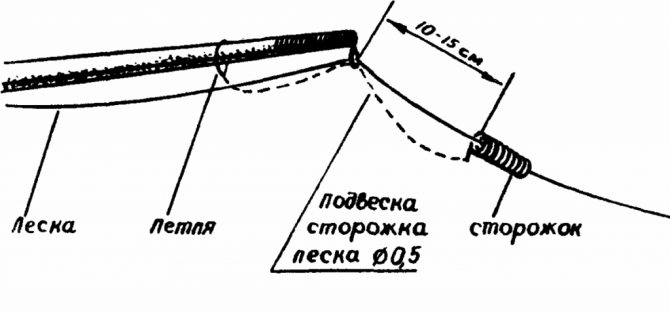
Rice. 53. Hanging alarm Already at the moment when on the shore he begins to lay out the fishing line for casting, all worldly worries leave his head. Attention is focused only on working with the tackle. The fishing line and hooks must be laid on the ground so that they do not get tangled or caught on the grass during casting. What will happen otherwise is not difficult to imagine. A tangled line will not allow the bait to land in the intended place, and a caught hook will not allow you to cast at all. If the shore is clear (sand bank) and there is enough free space, preparing the gear does not pose any particular difficulties: pull out the fishing line to the casting length, lay it along the shore and bait the hooks with bait. But, unfortunately, such shores, especially on lakes, are a rare occurrence. Usually rivers, lakes and ponds are framed by abundant vegetation. And you have to look for a “window” in it to position yourself with a fishing rod. What should a donkey not do in this case? Some hurry-ups do not bother to re-sort the fishing line after unwinding it from the reel. And they make a mistake: after all, at first the rings of the fishing line lie at the angler’s feet in the reverse order of how they should leave the ground, i.e. the ring, which is destined to be the first to fly into the air, ends up at the very bottom. And it rarely happens that it follows the load without interference. So, so that the fishing line can freely stretch out over the entire casting length, it is folded in rings onto a cleared place, or better yet, onto a raincoat (being careful of buttons), in such a sequence that the first ring from the reel lies at the very bottom, and the one closest to the sinker lies on at the very top. Then all the rings, one after another, will freely fly away to their destination. They will fly away... But first we need to send the sinker on this flight. There are several ways to cast a donkey. Let's consider the simplest one. So, the fishing rod and reel are firmly stuck into the ground, the fishing line is laid, and the hooks are baited. With three fingers of the right hand (thumb, index and middle) they take the fishing line slightly higher than the leash, lift the load and swing it back and forth. If there are several leashes, they are lifted into the air with the left hand. When, after several swings, the load reaches its rearmost position, it is sent forward and upward with a strong jerk.
Rice. 54. Casting a donkey With this casting option, you need to unwind so much fishing line from the reel so that part of it remains on the shore after the load touches the surface of the water. If the fishing line is less than the estimated length, the load can either tear the fishing rod out of the ground and carry the poorly secured tackle into the water, or, having pulled out the entire fishing line, change the direction of flight to the opposite (like a ball hitting a wall), and then it is possible that the fisherman himself will be hit . After the load falls to the bottom - this will be immediately visible from the sag of the fishing line - the excess fishing line is pulled out to a weak tension and the load is hung on it. Then all that remains is to wait for the “bell ringing”. Some anglers cast the weight with slings. They take a meter-long wooden strip, make a depression at one end of it, place a load in this depression and, swinging it widely, send it to the intended place. The sling, of course, makes casting easier, but, I think, not so much that it’s worth carrying an extra “log” in the case. Beginners should also be warned against this option, when the load is rotated in a vertical plane before casting. Even an experienced angler cannot always catch that brief moment when it is necessary to release the fishing line from his hand. Most often, after rotation, the load ends up not in the water, but in the bushes on the shore. You also cannot cast by placing the sinker and leash with the hook on the palm of your hand. At best, the sinker will not fly far. At worst, the hook will stick into your hand.
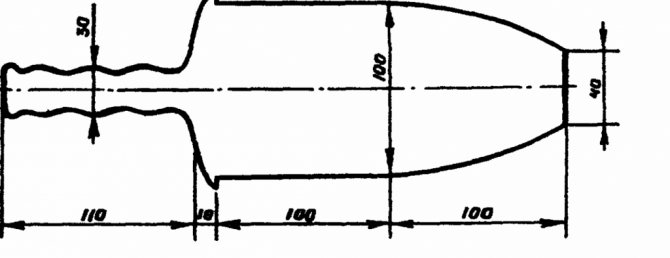
Rice. 55. Shovel for casting donkeys Recently, many amateurs have equipped donkeys with rods with reels and guide rings. This allows you to cast the bait further and more accurately, and be less dependent on fishing conditions. You can wind the line onto the reel faster and more accurately when biting. A long rod makes it easier to catch large prey. As you can see, the new gear has many advantages. However, this does not reduce the ranks of adherents of the old donkey. Although the process of its improvement is quite intensive. For example, in order to completely eliminate contact of the fishing line with the coastal grass when casting a donkey, craftsmen invented a device calling it a “shovel” (the diagram is shown in Fig. 55). The “shovel” is made from wood, vinyl plastic or ebonite. The fishing line is wound around it from the hangers to approximately the middle of the hull, where the bevel of the bow begins. Then they take the spatula in their left hand, aim it at the place they like, and with their right hand, as usual, they lift the load, swing it and make a cast. In this case, the fishing line comes off the device unhindered and comes off exactly as much as the load can pull. The same principle applies to devices constructed from cans, metal cylinders, frames bent from steel wire, etc. But then the long-awaited bell rang! This means that the fish made a sharp jerk, and the angler should not yawn with the hook. The nature of hooking with a bottom fishing rod can be different. If the cast is made far and the line forms an arc under the influence of the current, then you need to hook with a wide stroke, grasping the line below the guard. If the cast was close and the line remained taut, a short movement of the wrist is enough. However, such sharp jerks, when the bell is pouring with might and main, are not always made by the fish that has bitten, and small ones - never. Usually, short tremors are observed at first, and the bell trembles slightly at this time. Then, when the fish takes the bait, either a pull (the guard goes up) or a loosening of the line (the guard goes down) follows. You need to hook while stretching. Sometimes you have to hook when small shocks follow quickly one after another: this means that a small fish has taken the bait. Fishing for prey gives special pleasure. Fishing with a bottom fishing rod requires resourcefulness from the angler, the ability to navigate the situation well and the ability to make decisions instantly: after all, the fish has to be pulled to the shore, fingering the fishing line with his hands. It is enough to hold the line in your hand for a moment when the fish makes a sharp jerk - and the descent is inevitable. That is why, when fishing, you need to hold the line only slightly, so that with the slightest increase in the resistance of the fish, the line slips between your fingers. The main task of the angler is to tire the fish. When using even a strong fishing line, you must strive to ensure that it is stretched as little as possible: after all, the hook often catches the fish on the edge of the lip or the membrane in the mouth. If the pulling force is excessive, this often leads to the loss of prey. In short, you need to have a clear idea of the forces that arise during fishing. A tired large fish must be pulled out of the water with a net; under no circumstances should it be lifted into the air on a fishing line, since in the air the weight of the fish increases sharply, so either the leash or the fish’s lip may not hold up and break.
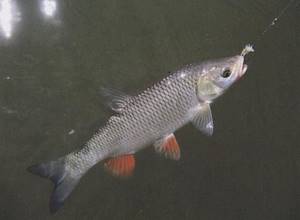
Discuss on the forum
Main line
Two types of fishing lines are used in spinning rods:
- braided cord;
- monofilament line.
Braid is more expensive, but with the same diameter as monofilament, it is much stronger. That is, for the donkey you can take a braided line of a smaller diameter, which will be less noticeable and fly better.
Disadvantages of braid:
- high cost compared to monofil;
- low extensibility.
In addition, many braided lines in the budget segment are poorly colored, and after several fishing trips all their camouflage is washed off.
Therefore, for donkeying from a spinning rod, it is better to take a monofilament fishing line with a diameter of 0.3-0.4 mm, transparent color, and it will be invisible in any water.
Important! After fishing, dry the fishing line, but not in the sun, and its service life will increase significantly.
Donka on a rod
With the advent of fishing reels on the market, it became possible to make long-distance castings of bottom gear. In addition, the use of a fishing rod made it possible to increase the accuracy of throws. Now the bait is delivered almost to one point with a slight spread over the area.
To create a donkey of this type, a durable rod up to four meters long is used. It can be used as:
- telescopic fishing rod,
- Chinese spinning rod "crocodile" type,
- rod with auto hooking function.
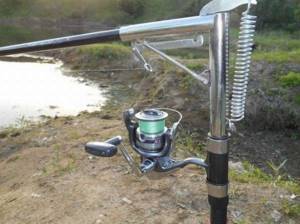
The function of the hook hook on the fishing rod is performed by a powerful spring. Attention! The auto hooking fishing rod is easy to assemble yourself. There are corresponding drawings and diagrams on the Internet.
A donkey reel is installed on the selected fishing rod. Most often today they use inertia-free, but there are amateurs who prefer the good old inertial model.
In terms of size, the inertialess meat grinder is selected to be 3000–5000 units in order to accommodate a sufficient amount of thick fishing line. Most often, a monofilament with a thickness of 0.30–0.35 millimeters is chosen as a base. However, if the elegance of the tackle is important when catching small fish, the diameter can be reduced to 0.20–0.25 millimeters.
To increase the sensitivity of the tackle, you can use the feeder option, which uses thin braid in combination with a monofilament shock leader. Approximate average diameters in millimeters are as follows:
- braided cord – 0.14–0.20,
- monofilament nylon – 0.25–0.30.
Review of the donkey device with a rubber shock absorber
The donkey rig on the rod can be anything. It depends on the conditions of the reservoir, the type of intended trophy and the personal preferences of the fisherman. Let's list the main installations:
- loop feeder equipment,
- paternoster,
- inline simple and with a tap,
- helicopter,
- garland,
- smoktuha.
Depending on the direction of fishing, sinkers or feeders are used in the donk. Their weight and shape are chosen depending on the following conditions:
- The presence of a current and its strength - flattened models with a large weight are used on the river.
- Type of fish - a feeder is usually not placed on a predator.
- Structures of the bottom of the reservoir - a heavy feeder can sink in soft silt.
- Desired casting distance.
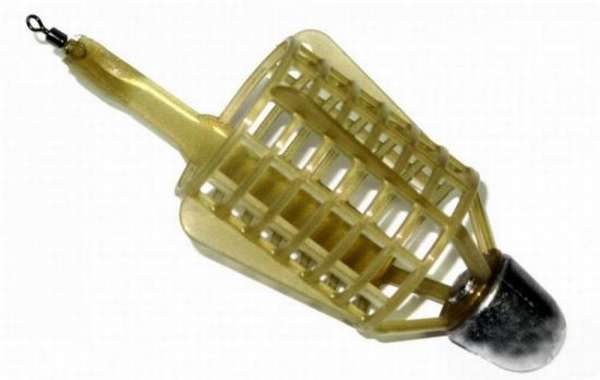
Bullet feeders have a particularly long range.
Leashes and hooks in a spinning rod are used on the same principle as for other gear, depending on the fish and the bait with which they are going to catch it.
Advice! When fishing with live bait, it is advisable to use a metal leash; this will protect the tackle from the sharp teeth of the pike.
Donkey installation
A spinning rod is a sensitive and reliable tackle, but to ensure this sensitivity you need to use a sliding sinker. The advantages of this installation are that when a fish takes the bait, it does not feel the weight of the load and is not frightened, as is the case with a bait donkey. This is especially true for trophy fish, which are very careful and attentive to unfamiliar objects.
On the one hand, she is attracted by the smell, color and taste of the nozzle, but, on the other hand, she needs to remain careful and attentive. A sliding sinker allows the fish to swallow the bait without fear and pull it to the side, and at this moment the movement of the sinker along the fishing line stops and a hook occurs. At the same time, the load itself must be flat so as not to move along the bottom under the pressure of the current and the pulls of the fish.
To install a spinning rod you will need:
- a piece of fishing line 40 cm long, 0.25 mm in diameter;
- sliding sinker;
- triple swivel;
- float stops;
- two leashes 15 cm long, with hooks made of monofilament fishing line with a diameter of 0.2 mm.
Installation procedure:
- make a loop from one end of the fishing line for tying to the base;
- pull the float stopper onto the fishing line and guide it to the loop;
- pull the sinker along the fishing line;
- put on another float stopper;
- tie a triple swivel to the free end of the fishing line using the upper ring;
- lower the lower stopper to the swivel;
- tie leashes to the free rings of the swivel.

Installation is simple, but catchy, and for different fish. When fishing for crucian carp or bream, leashes are made from monofilament fishing line. If the catch is expected to include carp or catfish, the leashes are knitted from soft braid and their length is shortened to 5–7 cm. Short leashes are less tangled and do not create problems for the angler when fishing and casting.
The stoppers limit the movement of the weight along the line, and the lower stopper prevents the weight from hitting the swivel assembly during power casts. If the hook gets caught on a snag or grass, only the leash tied on a thin fishing line comes off, and the rest of the equipment remains intact. To restore the tackle, you only need to tie a new leash or leashes.
Donka with a float
Let's look at another way of rigging, this is a donk with a float. Small rivers are interesting because the fisherman needs to apply the maximum of his knowledge and skills in order to catch a really large fish. I have noticed that even in very narrow “streams” there are such specimens that you simply wonder where such fish come from. But, at the same time, as I already noted above, catching fish in small reservoirs and rivers is a difficult undertaking, since the fish in such places are quite shy and react to minimal changes in the environment, both aquatic and those within the reach of fish above the surface of the water (study the question of fish vision).
It is in such areas that summer jig tackle and a bottom with a float mounted on a telescopic rod have proven themselves to be excellent, which helps when you need to carefully approach the shore, camouflage yourself, and identify a promising place, the depth of which rarely exceeds 1-2 meters.
Scheme of a donkey with a float
A bottom fishing rod with a float is a reality. The principle of such a donkey is as follows: in essence, it is an ordinary float fishing rod; a sliding weight is used as a sinker (I use a conical sinker that is not carried away by the current). The load is secured by a bead or swivel. The most interesting thing is that the float should only protrude slightly above the surface of the water. And while many fishermen achieve this effect by raising and lowering the rod tip and simply adjusting the depth, I prefer to also load the lower antenna of the float with pellets.
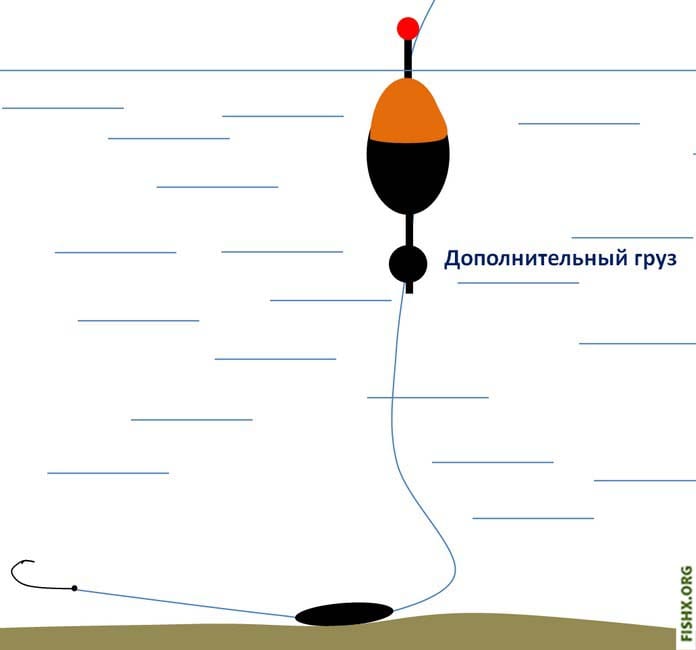
Why surround the float?
It’s simple, the less resistance the fish experiences when biting (and a sliding sinker already implies that there will be resistance), the more reliable and sure the bite will be. Therefore, the float, which is additionally loaded, will become a minor obstacle for the fish, which is what the fisherman needs. Such a bottom fishing rod is also interesting because you can successfully fish without even going close to the shore, which, you see, sometimes plays a key role in fishing.
From my experience I will say that using a donkey with a float I fished both in the current and in still water. I liked fishing on the current more, because... the fish grabs the bait more greedily. The catch most often included perch and roach. A couple of times I had to pull out bream too. So, try it, master this bottom fishing rod, and don’t forget about the many other variations of bottom fishing rods with a float.
In principle, I think we can stop here for now and draw some conclusions regarding donkey. Which? Decide for yourself.
I perceive the donka as a very diverse tackle, the variations of which are simply masses. Donk fishing is an experiment where you can always change and improve something. Use a float, a feeder, experiment with leashes, hook placement, bait, play with depth, use a variety of rigging methods and much more. So study and go fishing.
All the best to you and successful bottom fishing!
Donkey improvement
To spread the leashes as far apart as possible, a rocker arm is knitted instead of a triple swivel, but this reduces the reliability of the equipment, especially when fishing for heavy fish. When catching small fish, which often confuse the equipment, the use of a rocker arm is justified and even useful.
There is another trick that helps prevent tangling of hooks and improve the tackle - shorten one of the leashes to 5-7 cm; this installation works well for bottom-dwelling white fish such as bream or crucian carp.
To increase the overall attractiveness of the tackle, instead of a sinker, a loaded spring is used, into which bait is driven. This makes the tackle somewhat coarser, but the additional fish-attracting factor in the form of a bait mixture is still more important. During the current they use a stickier mixture, while in a still body of water it is “dusty” and this has a positive effect on catches.
The disadvantage of the spring is that in strong currents it rolls along the bottom and this creates inconvenience. In addition, when fishing with a donkey “under a clip,” the fisherman throws the tackle all the time in the same place and creates a kind of bait spot.
If the spring rolls along the bottom after casting, it is unlikely that such an effect will be achieved. But there is an opportunity to solve this problem and make a donkey with a spring that will not roll along the bottom and, moreover, is even more effective than a standard donkey, and this bottom tackle is called a “harvester”.
Donkey rigging
Today there are dozens, if not hundreds of different equipment for donkeys. It is simply impossible to describe them all. Let's focus on the most common and reliable options.
Simple option
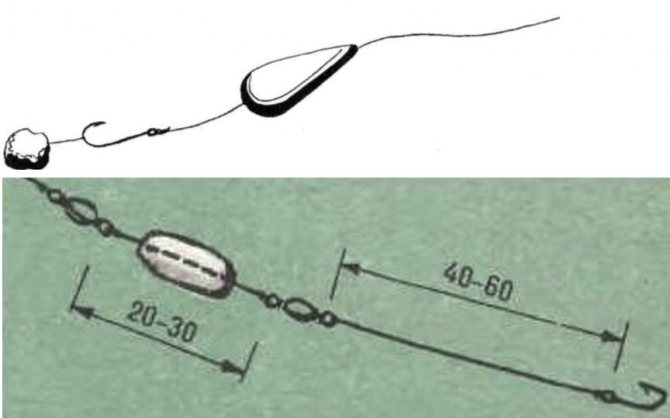
Despite its simplicity of equipment, this option is perfect for fishing for the largest trophy fish. In this case, only one node is used, so the strength of the equipment is beyond doubt.
We attach a sliding sinker in the form of a teardrop shape or an olive to the fishing line. To fix the sinker, you must use a silicone clamp. Remember that the stopper must be fixed firmly and rigidly enough. When casting the tackle, a significant load is placed on the stopper, but at the same time it must maintain its position. We can recommend that you use a soft lead pellet, which is clamped on the fishing line, as such a reliable stopper. A hook is tied to the end of the fishing line without a leash. It is also possible to rig it using a leash, which is attached through a swivel.
Equipment with spring
With equal success, a donkey rig with a spring is suitable for fishing with a rod and with hand casting. Equipment with a spring is especially effective when fishing in lakes and rivers with calm water.
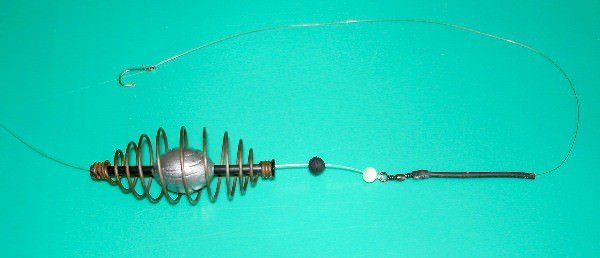
The first option is a sliding donkey with a spring. In our case, we replace the sliding sinker of the donkey with a spring. Viscous porridge or peas are easily stuffed into the spring. The choice of bait directly depends on the type of fish and its specific preferences in your pond.
The advantage of sliding equipment is that the fish does not feel resistance when biting, which is necessary for catching cautious and large fish.
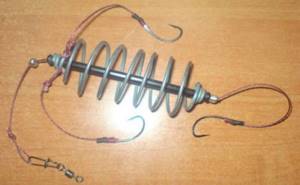
In the second version of the rig, short leashes are installed on the spring, which are recessed into the bait located in the spring. In fact, in this case, the bait is used as feeding and bait. The second option is perfect for catching bream and carp. In this version of the equipment, the fish detects itself, and the angler only needs to pull it out of the water. We can recommend that you use braided fishing line with a thickness of 0.1 - 0.15 millimeters for leashes.
If you are fishing in a strong current or there are deep holes and a sharp change in depth, it is recommended to install flat sliding sinkers directly in front of the spring. Such a flat shape of the sinker will not allow it to be carried away by the current.
How and from what to make a “harvester” donka

Donka “harvester” is a multi-hook tackle consisting of a feeder with loading and three leashes made of soft leash material. Bait is hammered into the feeder, and a floating bait is attached to the hooks, and this installation shows excellent results on lakes and rivers.
The main feature of the “harvester” is the design of the feeder, which is a spring with a flat lead bottom. After casting, such a feeder splashes down in a certain position and the hooks with the bait are always on top.
We can say that the donka “combine” is the progenitor of the now fashionable flat-method feeders, which help catch trophy fish.
How to assemble a catchy donka “harvester”
To make a “combine” donkey you will need:
- spring feeder with a flat weight;
- three leashes made of soft leash material 5–7 cm long;
- a piece of braided cord 30–40 cm with a diameter of 0.25-0.3 mm;
- stop bead;
- float stopper.
The rig is tied on a braided line to ensure strength and reliability during power casting and landing fish.
Assembling the “harvester” donka:
- At the end of the braid we firmly fix the mounting bead;
- we pass the braid into the feeder and lower it down to the bead;
- put on the float stopper and lower it all the way to the feeder, firmly fixing it;
- twist all the leashes together in one knot;
- 1–2 cm above the float stop we tie the leashes to the braided line;
- At the free end of the braid we make a loop to connect to the main fishing line.
How donka works
After completely assembling the “combine” donkey and attaching it to the main fishing line, bait is stuffed into the feeder, and techno-dough or foam balls are attached to the hooks. Hooks are stuck into the bait in rings, and the tackle is thrown into the water.
During the process of washing out the bait, the hooks are released and float in close proximity to the feeder. The fish approaches the aroma of the bait and, out of curiosity, tries the foam ball, getting caught by the hook.
The “harvester” donka is used to catch any bottom fish, and even wild carp bite on it. The strength of the tackle is enough for catching and landing trophy fish, and they can pull out crucian carp or bream without any problems.
Using foam plastic as a nozzle rather than technotest is preferable, because the synthetic material does not get wet and is not washed off with water for a long time, maintaining buoyancy. Fishermen use scented foam balls with the “combine” donkey, and this increases the attractiveness of the entire tackle.
Donka “combine” is used for fishing at any time of the year in open water, and this simple and catchy tackle is very popular among fishermen.
Making a spring for a “harvester”
How to make a flat lead weight was already described in the first part of the article, and when making a spring the process is very similar. Only after lead is poured into the sand mold is a spring inserted into it, and the structure is allowed to cool to normal temperature.
This is followed by processing the lead load with a file or emery, and the result is a spring feeder with a flat bottom and a streamlined shape. Such a feeder has flight characteristics at the highest level, and the location of the load ensures that it falls to the bottom of the reservoir in the only possible way.
The size of the donkey “harvester” feeder depends on the dimensions of the spring and, accordingly, the preferences of the angler who makes the choice.
Important! Do not make overly large springs, they are more difficult to cast, and too large a volume of bait does not provide any advantages.
How to make a fishing donk
Bottom tackle is not an object of industrial production and is mostly assembled by fishermen individually, for certain fishing conditions. In order to assemble bottom gear with your own hands, a fisherman must have the skills and ability to tie knots and have an understanding of the algorithm for assembling constructs into a single assembly.
The principle of operation of the equipment remains the same in all cases - supplying baits on the main cord with securing the equipment with a weight at the bottom of the reservoir. Next, we will dwell in more detail on the elements necessary for the manufacture of bottom gear with a description of their main operating properties and characteristics.
fishing line
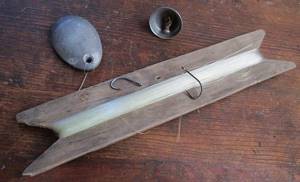
The donkey rig is formed on the main thread, which for short distances, up to 25 meters, is selected from monofilament fishing line, and for fishing at medium and long distances, a braided cord is used. The monofilament base is taken with a diameter of at least 0.2 mm, with the possibility of the fishing line being self-immersed under water and preferably in more stringent parameters. As a rule, clear fishing lines are universal for all shades of water. Braided cords for donk tackle begin to be used from a diameter of 0.15 mm. Braids, as well as monofilament, are chosen with strict characteristics, and when using this type of cord, the green shades of the material are most effective for all types of reservoirs, and in different seasons of the year.
Important! It is worth emphasizing that when fishing on shell rocks, regardless of the distance at which the bait is supplied, preference is given to monofilament cords with a lower abrasion coefficient compared to braided ones.
Sinker
Donka fishing can be done with either a dead or sliding weight. For the most part, teardrop-shaped lead sinkers are used for standing and weakly flowing reservoirs and flat types of shapes for rivers with moderate and fast currents. Drop-shaped weights and olive-shaped weights are not so noisy when casting, but do not stay on the bottom in currents, which, in contrast, ensures flat figures that are noisier when casting into fishing zones. A weight weighing 70 - 150 grams will more than ensure fishing in still waters, but for currents it is sometimes necessary to install a stationary weight of 500 grams or more.
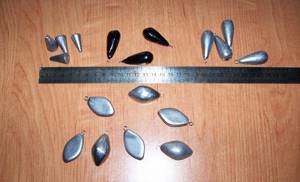
Important! Blind weights are mounted to the lines through swivels, selected depending on the weight of the load. The movement of sliding sinkers along the main cord is limited by silicone stoppers based on the distances required for fishing conditions.
Leash
The leader material is selected based on the type of fish being caught. For pike, use metal or Kevlar leashes. Catfish and pike perch attack baits on braided leashes without causing any significant deformation to them. All peaceful fish, depending on their caution and activity, can be successfully caught using monofilament or fluorocarbon leader materials. The length of the leash depends on the activity of the fish, its feeding method and the structure of the bottom at the fishing location. For active fish, short leashes are used, the sizes of which fall in the range from 15 to 25 cm. For passive fish and when fishing in silted reservoirs, longer leash sections are used. Additionally, under these conditions, leashes are equipped with foam floats, often the size of a pea to a walnut, which ensures that the bait is kept in the water horizon required for fishing.
Hooks
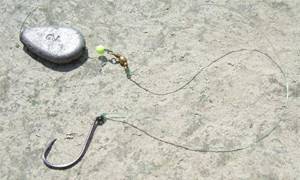
Hooks for equipment are selected based on the bait used and the size of the fish expected to be caught. It is better to prepare leashes with hooks at home in advance, on the shore only by retrofitting the tackle and without spending extra time on tying. For vegetable baits, use hooks with a short shank in the color of the bait. For animal bait in the form of a worm and crawler, as well as live bait fish, hooks with an elongated shank in blue and steel colors are used. In some cases, when setting fry as bait, it is effective to use a double and tees according to the size of the fish used for fishing. The shape and type of the connecting element of the accessory, be it a blade or a ring, do not fundamentally affect the installation design.
Important! The basis for the reliability of the leash-hook element is the competent choice of the type of connecting unit, depending on the material of the leash, and its correct execution.
